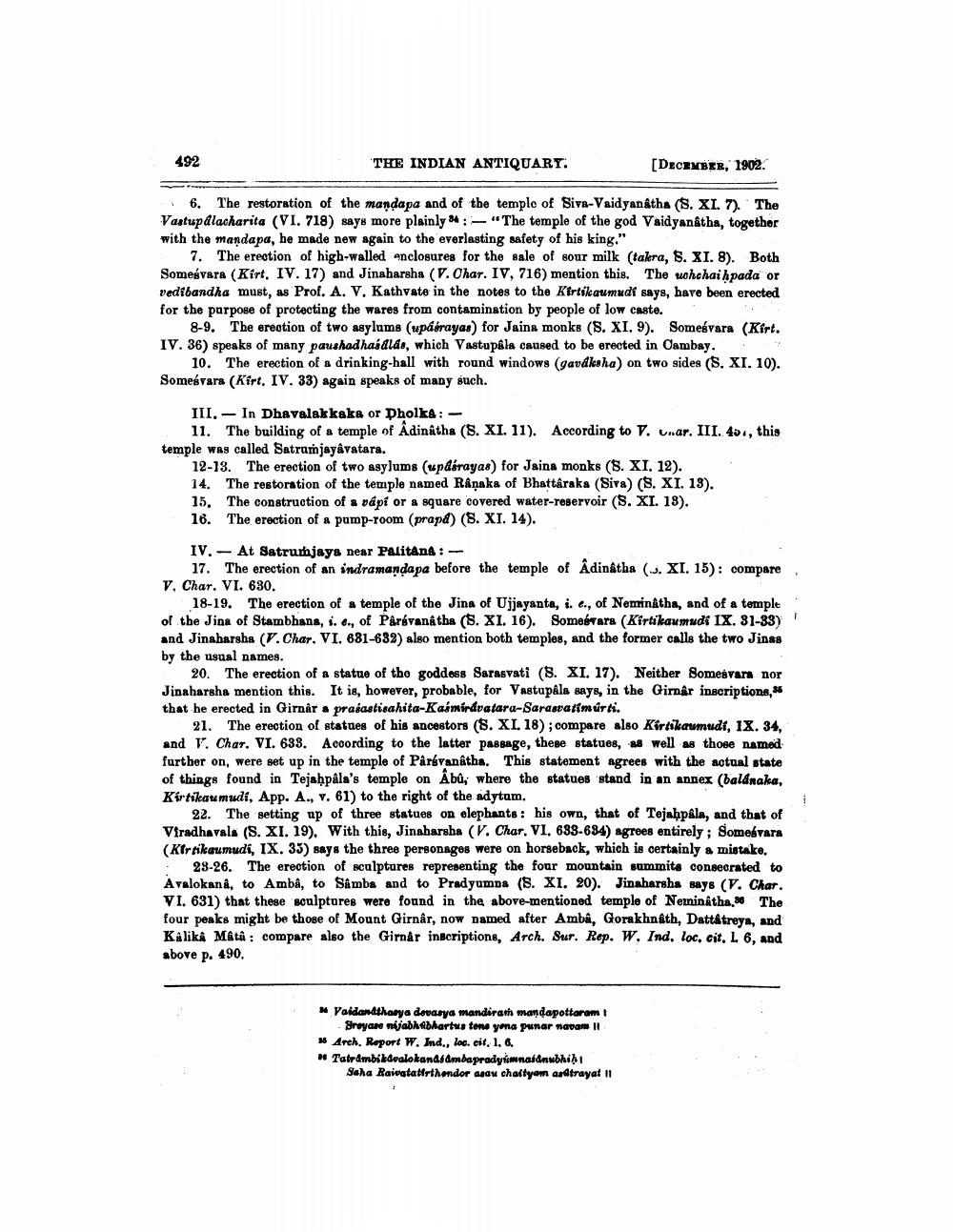________________
THE INDIAN ANTIQUART.
[DECEMBER, 1902.
6. The restoration of the mandapa and of the temple of Siva-Vaidyanatha (S. XI. 7). The Vastup dlacharita (VI. 718) says more plainly 4 : - "The temple of the god Vaidyanatha, together with the mandapa, he made new again to the everlasting safety of his king."
7. The erection of high-walled enclosures for the sale of sour milk (takra, S. XI. 8). Both Somesvara (Kirt. IV. 17) and Jinaharsha (V. Ohar. IV, 716) mention this. The wohchai hpada or vedibandha must, as Prof. A. V. Kathvate in the notes to the Kirtikaumudi says, have been erected for the purpose of protecting the wares from contamination by people of low caste.
8-9. The erection of two asylums (upáórayas) for Jaina monks (S. XI. 9). Somebvara (Kirt. IV. 36) speaks of many paushad hasdlds, which Vastupala caused to be erected in Cambay.
10. The erection of a drinking-hall with round windows (gavdksha) on two sides (S. XI. 10). Someávara (Kirt. IV. 33) again speaks of many such.
III. - In Dhavalakkaks or Dholks: -
11. The building of a temple of Adinatha (S. XI. 11). According to V. Unar. III. 45, this temple was called Satramjayâvatara.
12-13. The erection of two asylums (updórayas) for Jaina monks (S. XI. 12). 14. The restoration of the temple named Rånaka of Bhattâraka (Siva) (S. XI. 13). 15. The construction of a vápi or a square covered water-reservoir (S. XI. 18). 16. The erection of a pump-room (prapd) (S. XI. 14).
IV. -At Satrumjays near Palitang: -
17. The erection of an indramandapa before the temple of Âdinátha (w. XI. 15): compare V, Char. VI. 630.
18-19. The erection of a temple of the Jina of Ujjayanta, i. c., of Neminátha, and of a temple of the Jina of Stambhana, i. e., of Parsvanatha (S. XI. 16). Somescara (Kirtikaumudi IX. 31-33)! and Jinaharsha (V. Char. VI. 681-632) also mention both temples, and the former calls the two Jinas by the usual names.
20. The erection of a statue of the goddess Sarasvati (s. XI. 17). Neither Somesvara nor Jinaharsha mention this. It is, however, probable, for Vastupala says, in the Girnar inscriptions, that he erected in Girnar a prasastisahita-Kaimindvataru-Sarasvatimúrti.
21. The erection of statues of his ancestors (S. XI. 18); compare also Kirtikaumudi, 1X. 34, and V. Char. VI. 633. According to the latter passage, these statues, 48 well as those named further on, were set up in the temple of Pårsvanatha. This statement agrees with the actual state of things found in Tejahpåla's temple on Abû, where the statues stand in an annex (balanaka, Kirtikaumudi, App. A., v. 61) to the right of the adytum.
22. The setting up of three statues on elephants: his own, that of Tejahpala, and that of Viradhavala (S. XI. 19). With this, Jinabarsha (V. Char. VI, 688-684) agrees entirely ; Somebvara (Kirsikaumudi, IX. 35) says the three personages were on horseback, which is certainly a mistake. • 28-26. The erection of sculptures representing the four mountain summits consecrated to Avalokana, to Ambå, to Samba and to Pradyumna (S. XI. 20). Jinaharsha says (V. Char. VI. 631) that these sculptures were found in the above-mentioned templo of Norninátha,30 The four peaks might be those of Mount Girnâr, now named after Ambá, Gorakhnath, Dattatreya, and Kalika Mata : compare also the Gimnår inscriptions, Arch. Sur. Rep. W. Ind. loc. cit. 1. 6. and above p. 490.
# Vaidandthasya dovasya mandiranh mandapottaram
Sroyane nijabhabhartus tone yana punar navam 11 38 Arch. Report W. Ind., loc. cit. 1. 6. * Tatrambikdvalokandfdmbapradyumnafanubhihi
Saha Raivatatirthendor adau chatyam astrayal II




